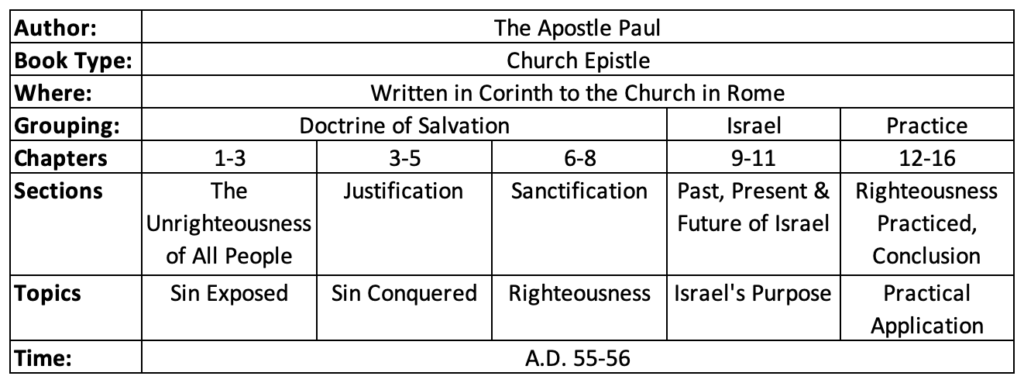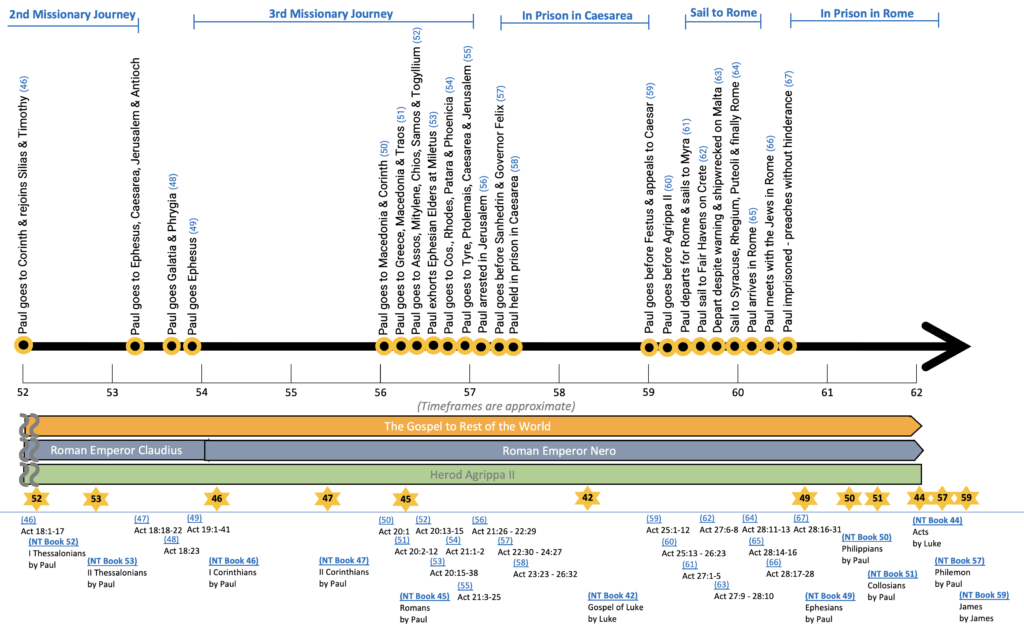Romans
The Definitive Gospel According to Paul
Summary | About | Why You Should Read it | Author | When Written | Context | Timeline | Location | Outline | Observations | Resources
Summary
Paul’s primary theme in Romans is the basic gospel, God’s plan of salvation and righteousness for all humankind, Jew and Gentile alike (see 1:16-17 and notes). Although justification by faith has been suggested by some as the theme, it would seem that a broader theme states the message of the book more adequately. “Righteousness from God” (1:17) includes justification by faith, but it also embraces such related ideas as guilt, sanctification and security.
Paul’s purposes for writing this letter were varied:
- He wrote to prepare the way for his coming visit to Rome and his proposed mission to Spain (1:10- 15; 15:22-29).
- He wrote to present the basic system of salvation to a church that had not received the teaching of an apostle before.
He sought to explain the relationship between Jew and Gentile in God’s overall plan of redemption. The Jewish Christians were being rejected by the larger Gentile group in the church (see 14:1 and note) because the Jewish believers still felt constrained to observe dietary laws and sacred days (14:2-6).
The table below is a high-level look at the structure and contents of the Book of Romans.

About
This is the first of the New Testament books written by Paul. It is the sixth book of the New Testament.

Why You Should Read It
Romans is probably the most complete and thorough explanation of salvation in the entire bible. The first eight chapter of the book focuses on explaining the need for salvation, which details the state of our sinful nature, followed by explaining how we are justified by faith in Jesus. Paul then goes into explaining how we are “sanctified” once we are “justified”. That explains the process the Holy Spirit takes us through in leading us away from sin and into God’s righteousness.
Paul then spends three chapters explaining to the gentiles the past, present and future state of the Jews. This is a very clear explanation of the fact the God is not done with the Jews and the Church does not replace them, as those say who falsely believe in “replacement theology”. Why does Paul spend so much time explaining to gentiles what God’s plan is for the Jews? Because God has a specific plan for them and the gentiles need to understand how God sees the Jews and the Church.
The last five chapters are Paul’s typical way of putting into practice what he has taught us this far. They deal with the practical application of the lessons in the first part of the book.
The book of Romans is considered by many, even those outside the theological realms, to be one of the greatest masterpieces of literature every written. It is taught by many law schools as one of the most solid logical arguments ever presented. It lays out a strategy of argument that cannot be defeated. Paul makes it clear our need for God’s salvation and how to attain it.
Author
The author of the book of Romans is clearly identified in Romans 1:1 as Paul. There was no disagreement in the early church as to the authorship of this book. The letter contains a number of historical references that agree with known facts of Paul’s life. The doctrinal content of the book is typical of Paul, which is evident from a comparison with other letters he wrote.
When Written
The book was probably written in the early spring of 56 A.D. Very likely Paul was on his third missionary journey, ready to return to Jerusalem with the offering from the mission churches for poverty- stricken believers in Jerusalem (see 15:25-27 and notes).
In 15:26 it is suggested that Paul had already received contributions from the churches of Macedonia and Achaia, so he either was at Corinth or had already been there. Since he had not yet been at Corinth (on his third missionary journey) when he wrote 1 Corinthians (cf. 1Co 16:1-4) and the collection issue had still not been resolved when he wrote 2 Corinthians (2Co 8-9), the writing of Romans must follow that of 1,2 Corinthians (dated c. 55).
Context
At the time of writing, the Roman believers were dealing with persecutions from the Roman government. Emperor Claudius had dealt with the Jewish revolt in which the Jews were expelled from Rome in 52 A.D. The Romans considered the followers of “the Way” a sect of Judaism and many of the Christians were also expelled from Rome at the time. In 54 A.D., Nero took over as emperor. Although at first, his demeanor towards the Christians wasn’t as harsh as it later became.
Paul wrote this epistle before the heavy persecution began, which followed after Nero’s own troops started the massive fire referred to as the burning of Rome in the early 60’s A.D. Nero conveniently blamed the Christians for the fire and then began the sever persecution that led to the execution of both Peter and Paul.
Paul’s letter was to the gentile believers in a very pagan Rome. Paul’s purpose in writing the letter was to strengthen the believers and help them better understand the doctrines Jesus wanted them to hold tight to. This epistle is considered by many to be the gospel according to Paul. It is a book focused heavily on the doctrine of salvation. Paul wanted his readers to understand what salvation was and how to attain it.
Many of the gentile believers in Rome had not heard from any of the apostles directly. They were having issues with the Jewish believers because they still felt a need to observe Jewish customs and hold to dietary restrictions. This was causing division among the believers, so Paul aimed to help both groups better understand each other and how they both had a role in God’s plan of redemption.
Timeline
This book was written on Paul’s third missionary journey in 56 A.D. The timeline below shows the general events of the New Testament during that time to put this book into context of what was happening when he wrote it.

Location
The letter was written to the Roman believers most likely from Corinth, which is in Greece, near Athens. The most likely place of writing is either Corinth or Cenchrea (about six miles away) because of references to Phoebe of Cenchrea (see 16:1 and note) and to Gaius, Paul’s host (see 16:23 and note), who was probably a Corinthian (see 1Co 1:14). Erastus (see 16:23 and note) may also have been a Corinthian (see 2Ti 4:20).

Outline
Introduction (1:1-15)
Theme: Righteousness from God (1:16-17)
The Unrighteousness of All People (1:18; 3:20)
Gentiles (1:18-32)
Jews (2:1; 3:8)
Summary: All People (3:9-20)
Righteousness Imputed: Justification (3:21; 5:21)
Through Christ (3:21-26)
Received by Faith (3:27; 4:25)
The principle established (3:27-31)
The principle illustrated (ch. 4)
The Fruits of Righteousness (5:1- 11)
Summary: Humanity’s Unrighteousness Contrasted with God’s Gift of Righteousness (5:12-21)
Righteousness Imparted: Sanctification (chs. 6-8)
Freedom from Sin’s Tyranny (ch. 6)
Freedom from the Law’s Condemnation (ch. 7)
Life in the Power of the Holy Spirit (ch. 8)
God’s Righteousness Vindicated: The Justice of His Way with Israel (chs. 9- 11)
The Justice of God’s Rejection of Israel (9:1-29)
The Cause of That Rejection (9:30; 10:21)
The Rejection Is Neither Complete nor Final (ch. 11)
There is even now a remnant (11:1-10)
The rejection is only temporary (11:11-24)
God’s ultimate purpose is mercy (11:25-36)
Righteousness Practiced (12:1; 15:13)
In the Body — the Church (ch. 12)
In the World (ch. 13)
Among Weak and Strong Christians (14:1; 15:13)
Conclusion (15:14-33)
Commendation, Greetings and Doxology (ch. 16)
Observations
- Some have called Romans Paul’s greatest work.
- Romans has been called “The Gospel according to Paul.”
- The Book of Romans explores the great significance of Christ’s sacrificial death.
- In Romans 16, Paul greets by name some 26 or 27 people in a congregation he has never visited.
- Romans was written near the end of Paul’s 3rd Missionary Journey.
- People from Rome were present in Jerusalem on the Day of Pentecost when the church began. Acts 2:10
- Tactius, a historian, referred to the Christians who were persecuted under Nero in 64 A.D. as “an immense multitude.”
- Each of the following words appear at least sixty times each in the Book of Romans:
- All
- Sin
- Righteousness
- Faith
- Law
- Background of Rome:
- Rome was founded in 753 B.C.
- It was the capital of the Romans Empire during the 1st century.
- Rome contained many magnificent buildings.
- It is believed that during Paul’s life that the population of Rome was estimated to be between three to four million people.
- What others have said about the Book of Romans
- Samuel Taylor Coleridge (a poet) – regarded Romans as the most profound book in existence.”
- Godet (a commentator) – called Romans “the cathedral of the Christian faith.”
- Meyer – referred to Romans as “the greatest and richest of all apostolic works.”
- Martin Luther – “This epistle is the chief part of the New Testament and the very purest gospel . . . it can never be read or pondered too much, and the more it is dealt with, the more precious it becomes, and the better it tastes.”
- Four great doctrines in Romans:
- Righteousness – The quality of being right or just with God.
- Justification – God pronounces those righteous whose sins have been forgiven.
- Election – God has predetermined a means of salvation.
- Sanctification – Set apart from evil ways.
“And we know that all things work together for good to those who love God and who are the called according to His purpose.”
Romans 8:28
Sections in Romans
- Understanding Salvation 1-8
- Israel, Past, Present & Future 9-11
- Concerning Christian Conduct 12-15
Theme
- The Doctrine of God: Wrath, Righteousness, Glory, Grace
- The Doctrine of Humanity: Fallen, Dead, Saved, Struggling, Freed
- Doctrine of Sin: Exposed, Conquered, Explained, Forgiven
- God’s righteousness is given to those who put their faith in Jesus Christ.
Jesus in Romans
- Jesus is the focus of the gospel and the means of salvation by God’s grace apart from works (1:1-4, 16-17).
